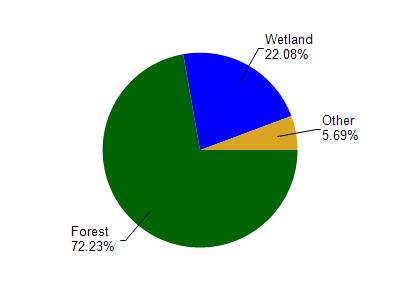
4.05 Miles
0 - 4.05
Macroinvertebrate, Coldwater
2015
Excellent
Douglas
Yes
Yes
No
Fish and Aquatic Life
Overview
Casey Creek is considered a Class I trout stream. Surveys from the 1970s noted that brook, brown and rainbow trout inhabit the stream, the latter species migratory from Lake Superior. At the time of the survey, beaver dams were blamed for silting in of spawning areas and temperature increases due to ponds. The streambed is mostly sand, gravel and boulder and is subject to seasonal flooding.
This stream has been identified in the coastal wetlands evaluation as a priority aquatic site. The watershed is almost entirely in the Bayfield Sand Barrens subsection and is forested. A very rare mayfly and a globally rare dragonfly breed in the stream. Dragonflies, caddisflies and mayflies were the dominant forms. The overall taxa richness at the site was moderate (5-24 species).
Date 1999
Author Aquatic Biologist
Condition
Wisconsin has over 84,000 miles of streams, 15,000 lakes and milllions of acres of wetlands. Assessing the condition of this vast amount of water is challenging. The state's water monitoring program uses a media-based, cross-program approach to analyze water condition. An updated monitoring strategy (2015-2020) is now available. Compliance with Clean Water Act fishable, swimmable standards are located in the Executive Summary of Water Condition in 2018. See also the 'monitoring and projects' tab.
Reports
Management Goals
Wisconsin's Water Quality Standards provide qualitative and quantitative goals for waters that are protective of Fishable, Swimmable conditions [Learn more]. Waters that do not meet water quality standards are considered impaired and restoration actions are planned and carried out until the water is once again fishable and swimmable
Management goals can include creation or implementation of a Total Maximum Daily Load analysis, a Nine Key Element Plan, or other restoration work, education and outreach and more. If specific recommendations exist for this water, they will be displayed below online.
Monitoring
Monitoring the condition of a river, stream, or lake includes gathering physical, chemical, biological, and habitat data. Comprehensive studies often gather all these parameters in great detail, while lighter assessment events will involve sampling physical, chemical and biological data such as macroinvertebrates. Aquatic macroinvertebrates and fish communities integrate watershed or catchment condition, providing great insight into overall ecosystem health. Chemical and habitat parameters tell researchers more about human induced problems including contaminated runoff, point source dischargers, or habitat issues that foster or limit the potential of aquatic communities to thrive in a given area. Wisconsin's Water Monitoring Strategy was recenty updated.
Grants and Management Projects
| Project Name (Click for Details) | Year Started |
|---|
|
|
Monitoring Projects
| WBIC | Official Waterbody Name | Station ID | Station Name | Earliest Fieldwork Date | Latest Fieldwork Date | View Station | View Data |
|---|
| 2862400 | Casey Creek | 10013277 | Casey Creek- Upstream Clevedon Road- Station #1 | 1/1/2015 | 1/1/2015 | Map | Data |
| 2862400 | Casey Creek | 10047355 | Casey Creek - U/S from confluence w/ Bois Brule River | 1/1/2015 | 1/1/2015 | Map | Data |
|

Watershed Characteristics
Casey Creek is located in the Bois Brule River watershed which is 199.64 mi². Land use in the watershed is primarily forest (72.30%), wetland (22.10%) and a mix of grassland (3.40%) and other uses (2.30%). This watershed has 220.94 stream miles, 3,539.94 lake acres and 18,373.66 wetland acres.
Nonpoint Source Characteristics
This watershed is ranked Not Ranked for runoff impacts on streams, Not Available for runoff impacts on lakes and Low for runoff impacts on groundwater and therefore has an overall rank of Low. This value can be used in ranking the watershed or individual waterbodies for grant funding under state and county programs.However, all waters are affected by diffuse pollutant sources regardless of initial water quality. Applications for specific runoff projects under state or county grant programs may be pursued. For more information, go to surface water program grants.
Casey Creek is considered a Macroinvertebrate, Coldwater under the state's Natural Community Determinations.
Natural communities (stream and lake natural communities) represent model results and DNR staff valiation processes that confirm or update predicted conditions based on flow and temperature modeling from historic and current landscape features and related variables. Predicated flow and temperatures for waters are associated predicated fish assemblages (communities). Biologists evaluate the model results against current survey data to determine if the modeled results are corect and whether biological indicators show water quaity degradation. This analysis is a core component of the state's resource management framework. Wisconsin's Riverine Natural Communities.